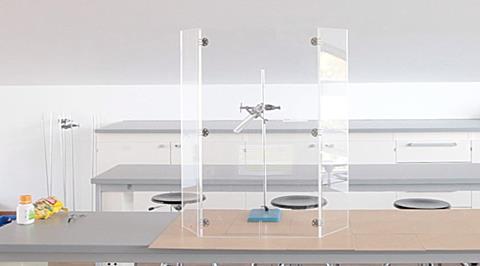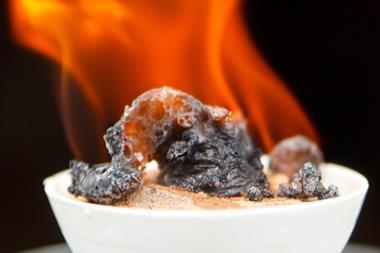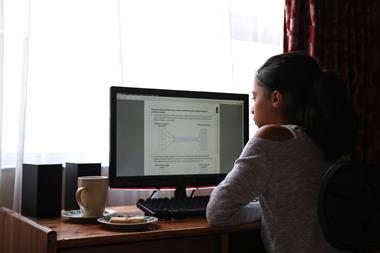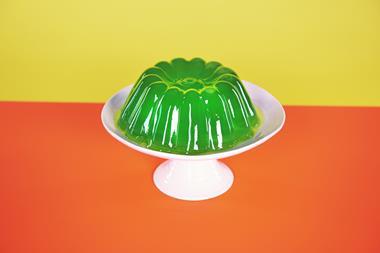Watch this
Watch the video and download the technician notes from the Education in Chemistry website: rsc.li/33eDCKO
As a child I could put away sweets without a second’s thought for their energy content. As an abstract concept, energy is really difficult to visualise. You can look at the numbers on the back of a sweet packet and calculate that with just one jelly baby you’d have enough energy to run for a few minutes or bring a cup of water to the boil. However, a simple calculation doesn’t necessarily bring the idea home because we take the heating power of a kettle for granted and metabolic processes take their time. To get a real sense of what approximately 100 kilojoules look like in action, you need a speedy reaction that packs a visceral punch. Having a sympathetic figure to destroy in the process can’t hurt the storytelling either, and this is where the ‘screaming’ or ‘howling’ jelly baby demonstration can really help.
Kit
- 7 g potassium chlorate(V) – reagent grade (may cause fire or explosion, strong oxidiser, harmful by inhalation/ingestion, toxic to aquatic life)
- UK-style jelly baby sweet
- Clean borosilicate boiling tube
- Bunsen burner
- Clamp stand and clamp (without rubber grips)
- Tongs
- Safety screen(s)
- Face shield
- Heat-resistant gloves
- Heat-resistant mats
Preparation
Set up this practical in the middle of a well-ventilated room, well away from the walls and with the windows wide open. Ensure there are no smoke detectors. You will need at least 2–3 metres of bench space, perpendicular to the audience. Protect the bench with heat-resistant mats. Set up safety screens to protect the audience and the demonstrator, and to ensure no ejected particles can come into contact with combustibles.

Weigh out 7 g of reagent grade potassium chlorate(V) and add it to the bottom of a thoroughly clean borosilicate boiling tube clamped at an angle steeper than 45° (so that the sweet will drop straight to the bottom of the tube) over a Bunsen burner. Line up the tube to point along the bench, away from the audience and demonstrator as well as from walls, displays and windows.
In front of the class
Students should remain 3–4 metres away wearing eye protection. The demonstrator should wear a face shield and heat-resistant gloves. Heat the base of the tube with the Bunsen burner until the potassium chlorate(V) just melts. Then do not wait: immediately remove the flame and drop in the sweet using a pair of tongs in your gloved hand.
Two reactions take place. The chlorate(V) decomposes to release oxygen:
2KClO3 ⟶ 2KCl + 3O2
And this in turn oxidises the carbohydrates in the jelly baby, somewhat faster and more dramatically than our bodies do through respiration. Those carbohydrates are predominantly sugar (sucrose, C12H22O11) and glucose (C6H12O6) syrup so one of the reactions on display is a good model for the net chemical reaction taking place in respiration:
C6 H12 O6 + 6O2 → 6CO2 + 6H2 O
Teaching goal
This demonstration is all about the drama, but a discussion of the energy on display is always helpful to anchor students’ understanding of this concept. According to the packet, the UK jelly baby is approximately 75% sugar by mass, with each sweet delivering approximately 100 kilojoules of energy.
Assuming no heat loss, this would be sufficient to raise just over 300 cm3 of water from 20°C to 100°C or, based on figures from Harvard Health Publishing, for a 70 kg person to:
- sleep for about 30 minutes
- walk for about 4 minutes
- cycle for about 2 minutes
- or sit in your class for another 10 minutes!
Health and safety
- CLEAPSS members should consult the Special Risk Assessment for this demonstration (SRA001), which was last updated in November 2019. Always check for the most up-to-date guidance.
- The use of sodium chlorate(V) is not advised. The potassium chlorate(V) must be reagent grade and the boiling tube must be absolutely clean and free of impurities, the presence of which have been suspected of causing accidents.
- The sweet must be a UK-style jelly baby. Other sweets such as gummi bears or sour versions of the same sweet must not be used as the ingredients in these sweets have been suspected of being involved with explosive accidents. The UK-style sweet has a high moisture content and relatively low surface area to mediate the reaction – sugar is not a suitable replacement (a completely different demonstration should be performed here at a much lower scale – CLEAPSS members can consult SRA032).
- Always practise in advance and do not deviate from the protocol or scale up – accidents have occurred.
- Wear a face shield and use safety screens to protect both audience and demonstrator. Students should remain 3–4 metres away.
- Do not use a fume cupboard – it will be overwhelmed by the fumes. A recirculatory fume cupboard has caught fire.
- The clamp should not have rubber grips, which could melt.
- All surrounding surfaces, screens, mats and the clamp stand should be washed thoroughly to remove any traces of ejected potassium chlorate.
Downloads
Technician notes - screaming jelly baby
Editable handout | Word, Size 0.12 mbTechnician notes - screaming jelly baby
Handout | PDF, Size 60.94 kb

























1 Reader's comment